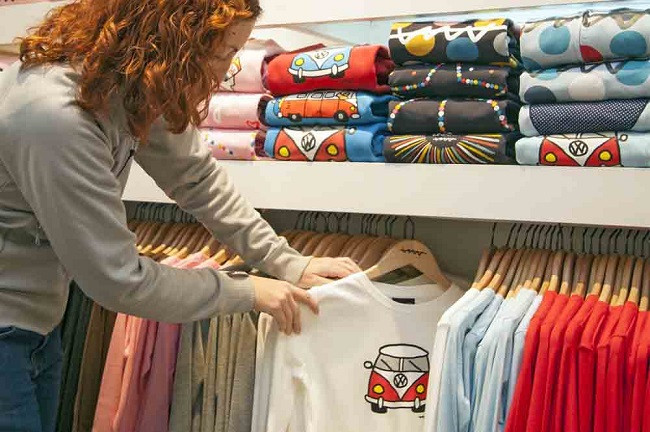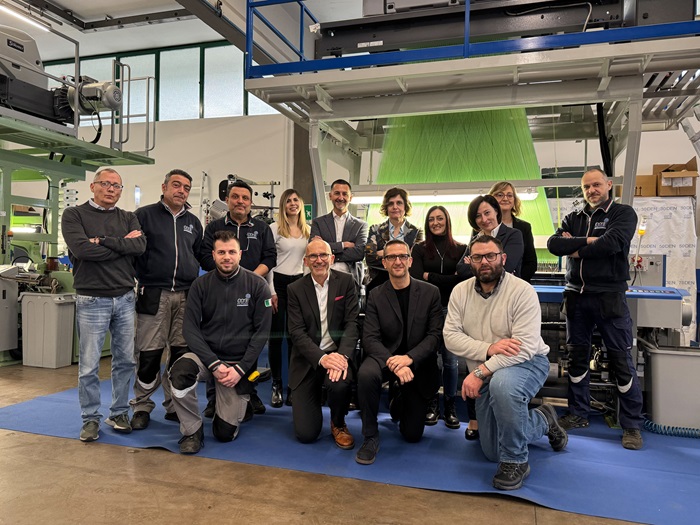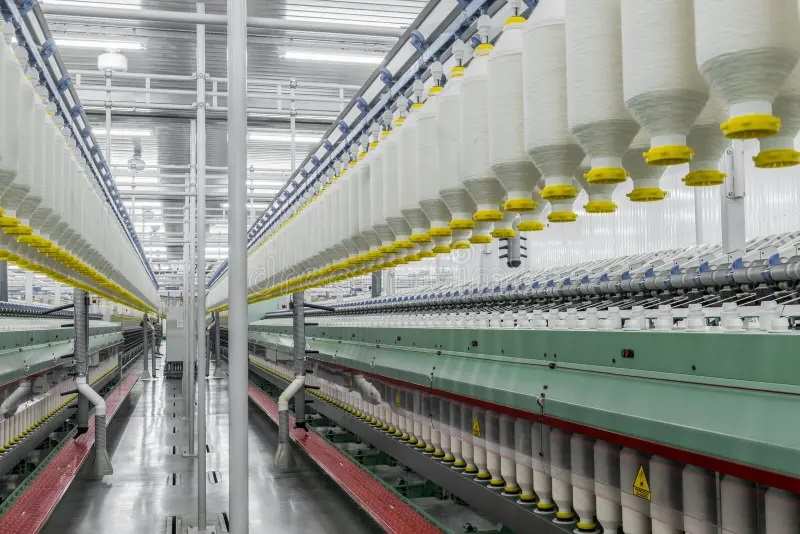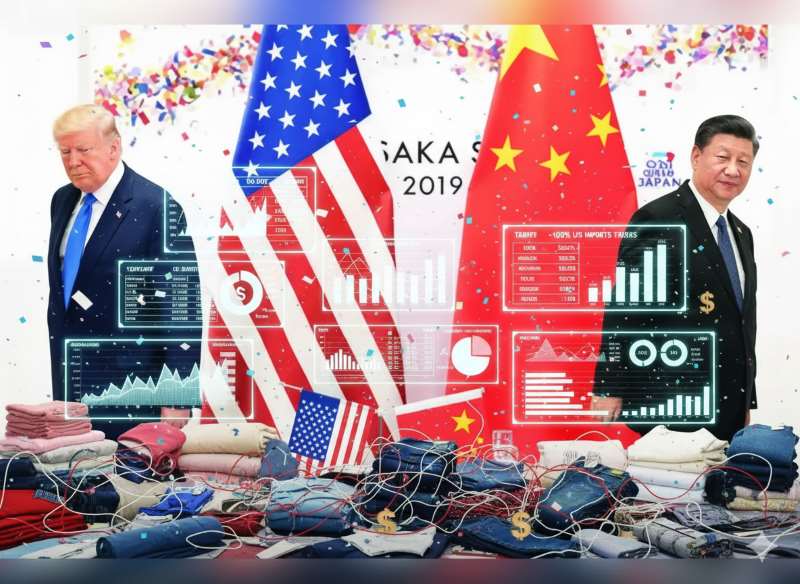FW

Texhibition Istanbul, a premier international trade fair for fabrics, yarns, and textile accessories, returns for its seventh edition from March 5 to 7, 2025, at the Istanbul Expo Center. With over 500 exhibitors and a 35,000-square-meter exhibition space, the event is expected to attract more than 25,000 trade visitors from 125 countries, including key markets such as the EU, UK, USA, North Africa, and the Middle East.
A leading platform for global buyers and producers
Since its launch in 2022, Texhibition Istanbul has become a key meeting point for textile industry professionals. The fair will feature a diverse range of products, including woven and knitted fabrics, yarns, denim, embroidery, prints, and textile accessories. This year, a dedicated Embroidery area will enhance the product lineup.
The event serves as a major platform for B2B meetings, connecting manufacturers with international buyers. Ahmet Oksuz, President of ITHIB, emphasized the fair’s significance, stating, "Our textile and apparel sector is projected to close this year with a production volume of over $80 billion. Sustainability remains a major focus for our exports, and Texhibition continues to be an essential source of motivation and innovation for our industry."
Innovation and sustainability in focus
Texhibition Istanbul sets industry standards by highlighting the latest trends in sustainable and innovative textiles. The Texhibition Trend Lab will showcase the latest color trends, high-quality fabrics, and creative designs, blending technology with sustainability to address climate change challenges.
The Innovation Hub Area, coordinated by Arzu Kaprol and Filiz Tunca, will feature cutting-edge technological advancements in textiles. Prioritizing health and environmental awareness, this section will present innovations across the supply chain, from fiber to fabric to apparel demonstrating how modern technology is shaping the future of sustainable fashion.
BlueBlack Denim: The future of sustainable denim
Denim remains a crucial segment of the global fashion industry, and Turkiye is among the world’s top producers of sustainable denim. The BlueBlack Denim Area will feature 21 leading Turkish denim manufacturers, including Bossa, İsko, and Kipaş. Exhibitors will present the latest advancements in eco-friendly denim production and design.
A key highlight will be the BlueBlack Denim Trend Area, featuring an eye-catching installation and a fashion show that blends innovation with contemporary denim styles. Turkiye’s strong textile infrastructure and commitment to sustainability continue to bolster its global standing in the denim sector.
Trend Seminars: Insights into the future of textiles
Texhibition Istanbul will feature a series of high-profile seminars and workshops led by renowned industry experts. These sessions will provide valuable insights into the latest trends and innovations shaping the textile sector.
Speakers such as Tatiana Aldrich (WGSN), Stefano Venchiarutti (Les Gentils Pariziens), Benedetta Lenzi (IED), and Arzu Kaprol will share their expertise on critical industry topics. Discussions will cover key areas such as Spring/Summer 2026 trends, sustainable textile design and innovation, and advancements in bio and biodegradable fibers.
Another focus will be the connection between natural resources and textile design, highlighting how sustainability is influencing material choices and production processes. These seminars will equip businesses with the knowledge needed to adapt to evolving sustainability regulations and stay ahead in a rapidly changing market.
A major highlight of Texhibition 2025 is the ReValue Stock Hub, an initiative designed to support sustainable business practices by marketing surplus fabrics. Through physical and digital showcases, this platform will help businesses find solutions for excess stock, contributing to waste reduction and circular fashion.
Turkiye’s position as a global textile leader
Turkiye remains a dominant force in the global textile industry, with textile and apparel exports reaching $30 billion in 2024. Of this, approximately $12 billion came from fabrics, yarns, and textile accessories. Key export markets include Germany, Spain, the UK, and the USA, where demand for high-quality, sustainable textiles is growing.
With continued investment in sustainable production technologies, Turkiye’s textile sector is strengthening its global competitiveness. "Texhibition Istanbul has solidified its position as a key global textile event, growing each year and showcasing Turkiye’s innovation and high standards. Our goal is to expand its reach and establish Turkiye as a central hub for the global textile industry," said Fatih Bilici, Vice President of ITHIB and President of Texhibition.
Future industry events
Following Texhibition Istanbul in March, the industry will witness more key events later in the year. Istanbul Fashion Connection is scheduled to take place from August 20-22, 2025, bringing together fashion industry leaders. Texhibition Istanbul will return for another edition from September 10-12, 2025, continuing its role as a central platform for global textile trade.
These events will further enhance Turkiye’s role in the international textile market, promoting innovation, sustainability, and global collaboration.
A cause of concern to local fashion brands, e-commerce platforms Temu and Shein are witnessing a rise in popularity in Nigeria as more consumers choose cheaper clothing options and opt for aggressive marketing tactics.
Known for their low prices, referral-based promotions, and constant social media advertising, these platforms have attracted a growing number of Nigerian shoppers. Many customers are drawn to the promise of free gifts for referring friends, while others take advantage of clothing items that cost as little as ₦5,000—a sharp contrast to the prices of many Nigerian fashion brands, which are often higher due to quality materials and production costs.
Social media has played a significant role in this shift, with Temu and SHEIN investing heavily in targeted ads across platforms like Instagram, Facebook, and TikTok.
This constant visibility has made it difficult for Nigerian brands to compete, as they often lack the financial resources for large-scale digital marketing campaigns.
As more Nigerians turn to these global platforms, sales of many local designers are on a decline. The focus on fast, mass-produced fashion is drawing consumers away from homegrown brands that emphasize creativity, quality, and craftsmanship.
Industry analysts suggest, higher import duties on fast fashion could help protect Nigerian businesses, while others believe local brands need to adjust their strategies by improving their online presence, offering competitive discounts, and adopting flexible payment options.
Despite these challenges, some Nigerian fashion brands are looking for ways to adapt and stay competitive. Many are exploring more affordable product lines, loyalty programs, and stronger digital marketing strategies to attract and retain customers. Others are emphasizing the uniqueness, durability, and cultural value of their designs, hoping to appeal to consumers who appreciate quality over fast fashion trends.
Australian fashion retailer Ally Fashion has gone bankrupt, leading to the closure of up to 185 stores across the country and leaving over 1,000 employees facing job losses.
The company’s liquidation was ordered by the Federal Court of Australia due to insolvency, marking another significant retail failure amid Australia's economic downturn, as per a report by the Daily Mail.
Founded in 2001, Ally Fashion was known for introducing 50 new styles per week for Autralian consumers. The company boasted of over 150 stores across New South Wales, Victoria, Queensland, South Australia, and the Northern Territory.
The retail company’s liquidation process will be monitored by Jeff Marsden and Duncan Clubb from BDO Sydney who will manage its financial affairs, and also oversee the shutdown process.
Professor Gary Mortimer, Retail Expert, Queensland University of Technology Business School attributes the company’s collapse to shrinking household budgets. According to him, the company suffered due to a rise in the cost of living which heavily impacted consumers’ discretionary spending on fashion, footwear, and accessories.
The closure has raised serious concerns about widespread job losses, with thousands of workers now unemployed, says Mortimer.
Besides, Ally Fashion, other major fashion brands, including Mosaic Brands—which owns Katies, Millers, Noni B, Rivers, and Autograph. entered voluntary administration last year. Luxury retailer Harrolds, popular label Dion Lee, and fashion chain Katies have also closed within the past year.
Despite an uncertain market environment, Hermès reported double-digit sales growth for both the Q4, FY24 and the full fiscal year.
The luxury brand’s revenue increased by 18 per cent to €4 billion ($4.2 billion), both on a reported and constant currency basis, in Q4 ended December 31 as against 11.4 per cent increase reported in Q3, FY24.
The brand also recorded a 10 per cent rise Asia sales, excluding Japan, despite a decrease in traffic in Greater China. Driven by the loyalty of local customers, their sales in Japan rose by 20 per cent.
Hermes sales in the Americas increased by 21.4 per cent during the quarter while those in Europe grew by 16.9 per cent.
For the full year, the brand’s revenue increased by 13 per cent to €15 billion, and consolidated net profit rose by 7 per cent to €4.6 billion.
The brand’s strong performance in 2024 even amid a more uncertain economic and geopolitical climate demonstrates the strength of the its sales model and its agility, says Axel Dumas, Executive Chairman.
The company remains committed to its fundamental values of quality, creativity and craftsmanship while also maintaining the group's key balances and its responsibility as an employer, he adds.
The company anticipates continued revenue growth in the medium term, despite economic, geopolitical, and monetary uncertainties.
The American Association of Textile Chemists and Colorists (AATCC) is set to host a series of conferences in 2025, tackling critical environmental challenges in the textile and apparel industry. These events will provide platforms for experts to collaborate on sustainable solutions.
Per- and polyfluoroalkyl substances (PFAS) remain a focal point in textile manufacturing, widely used for water repellency and stain resistance but increasingly scrutinized for their health and environmental risks. The 2025 PFAS Conference, scheduled for April 24-25 at the StateView Hotel in Raleigh, North Carolina, will facilitate discussions on responsible PFAS management. AATCC aims to unite stakeholders in updating best practices that safeguard consumers while ensuring sustainable industry growth.
With rising consumer demand for eco-friendly fashion, the debate between cotton and rayon continues. Cotton is valued as a natural fiber, while rayon, a man-made cellulosic fiber, is seen as a sustainable alternative. Both offer advantages like biodegradability and minimal microplastic pollution.
Renee Lamb, Assistant Professor at Virginia Commonwealth University, will lead a Digital Learning session on May 19, exploring the sustainability pros and cons of each fiber. The discussion will assess whether one fiber stands out as the ultimate sustainable choice.
As the textile industry shifts toward a circular economy, AATCC will host the Circularity Conference on June 17-18, 2025, at the University of Rhode Island, Kingston. Industry leaders, researchers, and policymakers will address challenges in creating closed-loop systems and reducing waste across the textile supply chain.
These conferences mark AATCC’s commitment to advancing sustainability in textiles, offering valuable insights for professionals seeking innovative solutions.
The American Apparel & Footwear Association (AAFA) has petitioned the Federal Trade Commission (FTC) to modernize care labeling rules by permitting digital labels, such as QR codes or URLs, instead of lengthy physical tags.
Current regulations, established in 1971, require manufacturers to affix care instructions on garments. However, the rise of global labeling requirements has led to oversized, multilingual labels with complex symbols that many consumers find difficult to read or simply cut off.
“Today’s shoppers demand clearer, more relevant information without being buried under pages of wasteful, uncomfortable labels,” said AAFA president and CEO Steve Lamar. “By embracing digital solutions, the FTC can unlock vast potential for consumers to gain more insights into the products they buy.”
According to industry estimates, apparel labeling requirements produce approximately 5.7 million miles (9.2 million kilometers) of label tape annually enough to reach the moon and back twelve times. AAFA argues that digital labels would streamline care instructions while reducing material waste.
Beyond convenience, digital labels could enhance transparency throughout a garment’s lifecycle, offering insights into resale, repair, rental, and recycling options. “This digital shift fosters more responsible, adaptable guidelines,” said Nate Herman, AAFA senior vice president of policy.
AAFA urges the FTC to align regulations with modern consumer behavior, where shoppers increasingly use technology to engage with fashion. The proposal seeks to improve accessibility, sustainability, and efficiency in apparel labeling.
The fourth edition of the Textile Leadership Conclave 2025 by the Global Chamber of Commerce & Industry (GCCI) will convene leading industry figures, policymakers, and entrepreneurs to explore the latest trends and innovations within the dynamic textile sector.
To be held on March 8, 2025 in Ahmedabad, the 2025 conclave will highlight critical industry issues, including optimizing cotton crop yields, fostering textile startups, and advancing technical textiles. It will host a comprehensive program featuring insightful keynote speeches, dynamic startup presentations, engaging panel discussions, and collaborative idea-sharing sessions. Notably, the event will also feature the launch of the Cotton Yield Mission and captivating fashion showcases by industry giants Arvind and LB Tex.
The esteemed keynote speakers for the event include Yogesh Kantilal Kusumgar, Founder, Kusumgar Pvt Ltd; Dr. Sundararaman K S, Managing Director, Shiva Texyarn Limited; and Nirav Mehta, Partner, Dima Products.
Held successfully in Ahmedabad in June 2024, the previous edition of the conclave was attended by leading industry experts and stakeholders, setting the stage for another impactful event in 2025. This event underscores GCCI's commitment to driving innovation and growth within the textile industry.

The intricate dance of textile and apparel trade between the United States, Canada, and Mexico is a microcosm of global economic forces, shaped by decades of trade agreements and increasingly challenged by geopolitical uncertainties. From the era of NAFTA to the present USMCA, the North American landscape has witnessed both remarkable integration and escalating tensions.
Historical Foundations: From NAFTA to USMCA
NAFTA, launched in 1994, fundamentally altered the region's textile and apparel sector. The ‘yarn forward’ rule, a cornerstone of NAFTA, mandated that all stages of production, from yarn to finished garment, occur within North America to qualify for tariff-free access. This fostered a tightly knit regional supply chain, but also led to the decline of some domestic manufacturing sectors in the US, as labor-intensive assembly shifted to Mexico.
The 2020 USMCA, while preserving many NAFTA provisions, introduced refinements. The de minimis threshold increase from 7 per cent to 10 per cent allowed for slightly more flexibility in sourcing non-regional materials. Moreover, USMCA expanded the list of North American origin requirements, notably including sewing thread, elastic fabrics, and coated fabrics, aiming to deepen regional production.
Data-Driven Insights: Trade flows and trends
Analyzing trade data reveals the dynamic nature of this sector.
Table 1: US Textile and Apparel Trade with Mexico and Canada (%Billion)
|
Year |
US Exports to Mexico |
US Exports to Canada |
US Imports from Mexico |
US Imports from Canada |
|
2018 |
6.3 |
5.2 |
5.6 |
0.9 |
|
2019 |
6.1 |
5 |
5.8 |
0.8 |
|
2020 |
5.8 |
4.7 |
5.5 |
0.7 |
|
2021 |
6 |
4.9 |
5.7 |
0.8 |
|
2022 |
6.2 |
5.1 |
5.9 |
0.9 |
|
2023 |
6.4 |
5.3 |
6.1 |
1 |
Source: US Office of Textiles and Apparel (OTEXA)
The data demonstrates a consistently strong two-way trade, with Mexico being a major partner. The steady growth of imports from Mexico shows the success of the coproduction model. The 2023 data shows a continued upward trend. According to statista, "In 2023, the value of US textile and apparel exports to Mexico amounted to about 6.9 billion US dollars." This shows how large of a trading partner Mexico is to the US In 2023, US textile and apparel exports reached $29.7 billion, with 53 per cent directed to Mexico and Canada ($12.3 billion). Mexico holds its place as a crucial exporter, with $9 billion in textile and apparel sent to the US Canada's specialization in high-value textiles, such as technical fabrics, is evident, with 64 per cent of its textile exports destined for the U.S.
USMCA's Double-Edged Sword: Benefits and burdens
USMCA's impact is complex:
Supply Chain resilience:
The agreement aimed to secure regional supply chains, vital in times of global disruption. However, reliance on a single region can also expose vulnerabilities.
Market Access and investment:
Duty-free access has spurred investment, particularly in Mexico's apparel sector. However, the threat of tariffs casts a long shadow.
The De Minimis dilemma:
The $800 de minimis threshold is a battleground. U.S. manufacturers argue it favors Asian e-commerce giants, leading to unfair competition and potential illicit trade. Advocates for de minimis point to the reduced costs for consumers and small businesses.
NCTO President Kim Glas has been very vocal about this loophole, and the danger it poses to the US textile market.
Anticipated scenario and future outlook
If the proposed 25 per cent tariffs are imposed, the anticipated scenario would see disruptions across the entire North American textile and apparel supply chain. Higher costs for raw materials and finished goods would likely force companies to seek cheaper alternatives outside the USMCA region, undermining the very goals of the trade agreement. Additionally, the closure of the de minimis loophole could help level the playing field for North American manufacturers but would also require robust enforcement to prevent transhipment and undervaluation practices.
In response to these challenges, Mexico has initiated strategies to reduce its trade deficit with China and attract more investment, aiming to strengthen its position within the USMCA framework and reduce economic dependence on non-member countries.
While these agreements have fostered growth and integration, evolving economic policies and global challenges continue to redefine the landscape. Stakeholders must remain adaptable, emphasizing innovation, ethical practices, and strategic partnerships to navigate the complexities of international trade in this sector.
US Reciprocal Tariffs Threat: Shifting supply chains, and India's ambitious play for a US trade deal

The clang of tariffs reverberates through the global textile and apparel industry, as the United States' strategy of reciprocal levies forces a dramatic restructuring of trade flows. The policy, designed to level the playing field, has ignited a fierce competition among major exporters China, Vietnam, India, and Bangladesh each vying for a larger slice of the lucrative US market. However, it's India that's emerging as a particularly keen contender, sensing a unique opportunity to capitalize on China's tariff-induced challenges and leverage a potential US trade deal to its advantage.
The Tariff Divide: A foundation for disruption
At the core of this trade upheaval lies the "tariff differential," a strategic tool employed by the US to address perceived trade imbalances. This differential the disparity between tariffs imposed by the US and those imposed by its trading partners creates a complex landscape where some nations face steeper levies than others. Data from Nomura reveals the stark contrasts:
|
Country |
Average Tariff Difference |
|
India |
15.60% |
|
Vietnam |
-12.30% |
|
Bangladesh |
9.37% |
This disparity directly impacts the cost competitiveness of these nations' exports. India and Bangladesh, with their positive differentials, face the prospect of higher costs in the US market, while Vietnam, with its negative differential, stands on comparatively firmer ground.
Export Dynamics: A data-driven shift
The impact of these tariffs is evident in the shifting export volumes. Data from the Office of Textiles and Apparel (OTEXA) confirms a decline in Chinese textile exports to the US, while Vietnam experiences a notable surge. This realignment is further illuminated by detailed tariff data:
|
Country |
Avg. Tariff on US Imports |
Avg. Tariff on Exports to US |
Source |
|
India |
24.80% |
9.20% |
Nomura |
|
Vietnam |
0.70% |
13% |
Nomura |
|
Bangladesh |
25% |
15.62% |
Nomura/World Bank |
The price sensitivity of the textile market amplifies these effects. Reports from market analysis firms indicate that manufacturers are grappling with increased costs, forcing them to absorb losses or seek alternative markets. India's Apparel Export Promotion Council (AEPC) highlights that 28 per cent of India's textile and apparel exports go to the US, with significant tariff variations lower duties on cotton fabrics and as high as 33 per cent on man-made fibers.
India's Two-Pronged Strategic Play: US trade deal and market share gains
With China facing considerable tariff pressure, and the US indicating a desire to enact reciprocal tariffs upon India, India sees not only an opportunity to expand its footprint in the US market, but a necessity to protect its economic interests. A planned bilateral trade agreement with the US could be used to push for increased textile exports, alongside other industries like agriculture, aluminium, and steel, to mitigate the potential damage from reciprocal tariffs.
This trade agreement is seen as a vital shield, ensuring that Indian exports remain competitive. The Global Trade Research Initiative (GTRI) has identified that while textiles face significant tariff differences, agricultural exports could be the most severely affected, thus highlighting the urgency of a comprehensive trade deal.
Vietnam and Bangladesh: Navigating the tariff maze
While India strategically pursues a trade deal, Vietnam and Bangladesh face their own set of challenges. Vietnam has surged to become the largest textile exporter to the US in the first five months of 2024, surpassing China. However, 70 per cent of both Vietnam's and Bangladesh's textile and apparel exports consist of ready-made garments, which face the prospect of higher tariffs.
Bangladesh, heavily reliant on its textile sector (11 per cent of its economy), and Vietnam, where textiles account for 15 per cent of the economy, are particularly vulnerable to tariff fluctuations. In contrast, India's diversified economy, with textiles contributing 2.3 per cent to its GDP, provides a buffer.
The Evolving Landscape: Adapting to change
The long-term implications of the US reciprocal tariffs remain uncertain. However, the global textile industry is undergoing a profound transformation. Manufacturers are diversifying their supply chains, investing in
|
Country |
2013 Textile Exports (USD Billion) |
2023 Textile Exports (USD Billion) |
Source |
|
India |
34.2 |
36.36 |
WITS, DGCI&S, GTRI estimates |
|
Vietnam |
23 |
45.2 |
WITS, DGCI&S, GTRI estimates |
|
Bangladesh |
27.74 |
46.4 |
WITS, DGCI&S, GTRI estimates |
The ability to adapt to these changes will determine the success of each nation. Future trends will be shaped by US trade policy, including the results of any potential trade agreements, technological advancements, and the growth of alternative markets. India, with its strategic vision and growing manufacturing capabilities, coupled with the pursuit of a vital trade deal, is poised to play a pivotal role in this evolving landscape.

Jakob Muller Group (JMG), a global leader in narrow fabric weaving machinery, has acquired 100 percent of MEI International, an Italian manufacturer of wide label weaving machines. The deal, effective January 1, 2025, aims to enhance JMG’s offerings with MEI’s specialized air-jet technology.
With over 50 years of experience, MEI is known for its advanced air-jet weaving machines. As part of the acquisition, JMG will discontinue its Mujet air-jet weaving machine and fully integrate MEI’s technology, ensuring continued innovation through joint expertise.
Key benefits of the acquisition:
Expanded product range: Customers will have access to a comprehensive selection of label weaving machines.
Accelerated innovation: The combined knowledge of JMG and MEI will drive the development of new products and services.
Stronger financial position: The partnership strengthens both companies’ financial footing, enabling increased investment in technology and customer support.
Customer continuity: Both companies will retain their sales and service structures to ensure seamless support.
“This acquisition is a key milestone in our JMG 2030 strategy,” said Andreas Conzelmann, CEO of JMG. “I deeply value MEI’s team, their commitment, and expertise. Together, we will offer an unmatched range of solutions while maintaining the highest standards of quality, productivity, and reliability.”
Paolo Mazzucchelli, CEO of MEI, added, “Partnering with JMG allows us to innovate faster and support our customers’ growth more effectively. We remain committed to our independent sales force to preserve long-standing customer relationships.”
MEI will continue operating independently from its Gallarate, Italy headquarters, with Mazzucchelli remaining as CEO. Both brands will maintain their separate identities while leveraging their combined strengths to navigate the evolving market.
About Jakob Muller Group
Jakob Muller Group (JMG) is a global leader in narrow fabric weaving solutions, operating in 82 markets with 11 locations. With 138 years of expertise, JMG prioritizes innovation, quality, and employee well-being while developing key technologies in-house or through exclusive partnerships.
About MEI International
Founded in 1974, MEI International is a leader in label weaving technology, known for innovation and customizable solutions. With a strong focus on quality and precision, MEI continues to advance textile innovation for the fashion industry and beyond.












